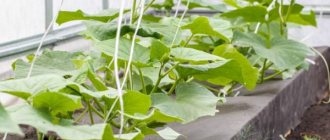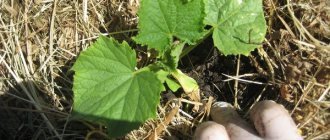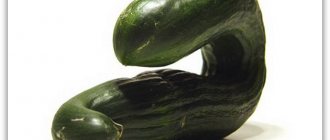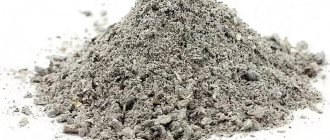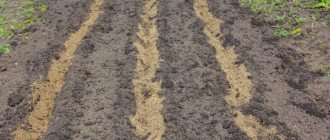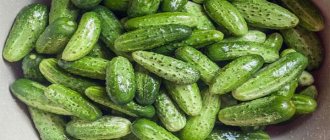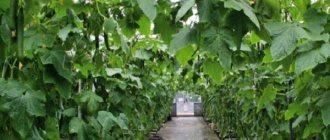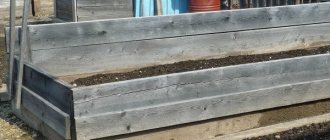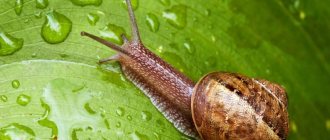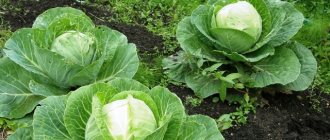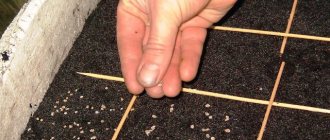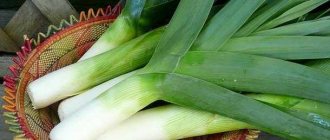Warm bed
What is this “warm bed” and how is it better than a regular one? Such a bed contains food debris, peat, leftover food, sawdust, and fertile soil.
The chemical reactions that take place inside the garden bed generate enough heat to keep the soil at a constant temperature.
In order to make a proper warm bed, you must follow the following sequence:
- Remains of wood. This includes wood chips, twigs, and small boards.
- Residues from plant food and leaves. Banana skins, vegetable and fruit peelings, onion peels, etc. are suitable.
- Compost or manure.
- Fertile soil.
Components that slowly rot (wood residues) must be placed at the very bottom of our bed. Due to the fact that they do not decompose immediately, the effect will appear only after a few years.
The layer that will decompose faster (food scraps, leaves) must be placed in the middle of the bed.
This layer decomposes in about two to three years. Manure or compost is placed last. They decompose within one season.
Preparing the soil for planting cucumbers
When setting up a site for growing cucumbers, it is optimal to make several beds 20-30 cm high, depending on the type of soil: the heavier it is, the greater the height of the bed. The width of the paths formed between the beds should be at least 0.5 meters. In addition, when using a vertical type of cultivation, in which cucumbers are woven along a net fixed to a special frame, it is necessary to place the beds in such a way that the nets do not block each other.
Latest articles about gardening
How to feed potatoes during flowering
Nettle juice medicinal properties
30 interesting facts about apples
Warm beds - pros and cons
The advantages of such beds include:
- Plant seedlings early, and accordingly we will get early fruits.
- The amount of fertilizer fed to plants is reduced. There is already enough manure in such a bed. Therefore, all that remains is the need to supplement with potassium, magnesium and microelements.
- The roots of the seedlings are always in a warm place. Thanks to this, all bad conditions are better tolerated.
Unfortunately, there are always disadvantages. Warm beds are no exception. Due to the use of manure, nitrates can accumulate in greens.
It is very difficult to minimize their number, since there is quite a lot of nitrogen in the soil. Even if you increase the amount of magnesium and potassium as a counterbalance to nitrates, this will not lead to anything.
If the weather in the spring is warm enough, the seedlings may “burn.” This nuance is most often observed in the southern regions.
Folk signs associated with cucumbers
May 15 (Boris and Gleb the sowers), sowing with dry seeds. To make the cucumbers grow strong, they buried a ring with them.
May 19 (Job borage), sowing seeds that have already hatched. According to the sign, if rich dew appeared on this day, expect an excellent harvest of cucumbers.
May 27 (Sidor-Borage). A clear day meant a rich harvest, but a cold and cloudy day did not bode well for cucumber production.
June 1 and 2 (Ivan Dolgiy and Philaleus-Borage). At this time, residents of the northern regions usually sowed cucumbers.
June 5 (Levon-Borage). This date was also considered favorable for the growth of cucumbers. Especially if there were a lot of gadflies in the air on June 5th.
Recessed bed
It is considered an ideal option for growing cucumbers in regions with insufficient moisture.
The drug Alatar for insect control: instructions, dosage, reviews, recommendations
Acaricidal fungicide Tiovit Jet: application features + instructions with detailed description
- Weed killer Hurricane: instructions for use, description, rules, pros and cons
This bed is located below ground level. You can grow plants on it for three to five years. Not very suitable for greenhouses.
This option is good because you won’t spend a lot of effort and money to create it. It retains moisture well and does not need to be dug up every year.
However, there are also disadvantages to such a bed - if there is heavy rainfall or the gardener overdoes it with watering, it can be severely washed out.
Due to the excessive amount of water in such a bed, the roots suffer, until they completely rot. All parasites that crawl on the ground easily get onto plants.
Preparing cucumber seeds before planting
You need to start by selecting empty seeds. Yes, you can often find only 10-12 of them in a bag. But even among such a small quantity there are empty, incomplete seeds, and therefore they need to be sorted.
1. Add a tablespoon of salt per liter of water and mix.
2. Dip cucumber seeds into the solution.
3. We drain those that have floated up: they are not full and unsuitable for planting.
4. We wash the rest and dry them on a napkin.
Bed flush with the ground
It is considered the simplest type. It's done quite quickly and easily. In this option, the bed is raised up to five centimeters above ground level. It only lasts a couple of years.
The advantages of such beds include their simplicity and speed of execution. It does not require any financial investment. The yield in such cucumber beds is average. Ideal for cold summer periods in the middle zone.
- Weed killer Tornado: detailed instructions for using the herbicide, photos, diagrams, description
Feeding tomatoes after planting in the greenhouse: step-by-step instructions, with photos and descriptions
Cucumber seedlings - how to properly prepare soil for seedlings and sow cucumbers at home
The disadvantages include that the edges are easily washed away during heavy rains, as well as with excessive watering. This risks leaching out useful substances from the soil.
From time to time you will need to strengthen the edges of the bed for cucumbers in open ground. All parasites easily fall on plants.
Autumn preparation
Autumn is the ideal time to apply a wide variety of fertilizers. They will have enough time to rot, ferment, and assimilate. When the time comes to plant cucumbers in the spring, all the fertilizers in the soil will already be in a form accessible to the plant.
Autumn garden preparation begins with removing plant debris and weeds. They should not be left in the garden, as they can serve as a source of pathogenic organisms. Therefore, all residues are taken off site and burned. You can put them in the compost heap. Weeds need to be removed especially carefully, because many of them have a powerful root system and at the first rays of sunlight in the spring they will certainly sprout again.
After this, you can start applying fertilizers. The following elements need to be added to the cucumbers:
- Urea – 20-25 g per 1 sq.m.
- Superphosphate – 18-20 g per 1 sq.m.
- Potassium chloride – 15-20 g per 1 sq.m. This fertilizer can only be applied in the fall, so that it has time to neutralize during the winter and become safe for plants.
- Fresh manure is 5-6 kg per 1 sq.m., it can be replaced with humus - 3-4 kg.
- Wood ash 250-300 g per 1 sq.m.
- To lighten too heavy soils, river sand is added in the fall - 1 bucket per 1 square meter, or mixed with compost. This technique will make the soil more airy and significantly increase its fertility.
- If the soil does not retain moisture well, then you need to add clay, 1 bucket per 1 square meter, or leaf humus 3-4 kg, or sawdust - 1 bucket. Only well-rotted sawdust is always used.
- When soil acidity is low (up to 4.5), lime is added to the soil at the rate of 200-250 g per square meter. at an acidity of 4.6-5.5, chalk is added to the soil in the same amount. These two components are added exclusively for digging. Liming is strictly prohibited if fresh manure is applied - as a result of such chemical reactions, the soil loses precious nitrogen. Therefore, it is necessary to carry out one of these procedures.
- The autumn digging itself is carried out using the moldboard method. That is, all lumps of soil must be turned over and broken. This method allows you to move fertilizers inside the soil, and, on the contrary, remove all pests to the surface, where they die during wintering.
Recommendations for planting cucumbers in beds
Experienced gardeners recommend listening to advice regarding planting cucumber beds in open ground.
Be sure to first figure out when to plant vegetables. It is recommended to plant in the spring, when the air temperature remains at 15 degrees Celsius.
Don't forget to consider the climate of your region. For example, gardeners living in the north can plant cucumbers in their beds at the end of May, and the central regions begin planting them in mid-May.
Variety of beds for cucumbers
Cucumber beds “Layer Pie”. You can prepare beds for vegetables using the “Layer Pie” method. According to many experienced gardeners, this is a very practical and expedient way to grow cucumbers.
Lay in the dug trenches in layers:
- 1 layer. Coniferous spruce branches or finely chopped brushwood.
- 2nd layer. Compost.
- 3 layer. Peat.
- 4 layer. Sawdust or straw.
- 5 layer. A little manure, you can replace it with humus and ash.
- 6 layer. Fertile soil 20 cm high.
Choosing a landing place
In order for your cucumbers to produce good harvests, they should be planted in the right place.
How to make a bed for cucumbers in open ground and choose the right location? To do this, choose a place that is well lit and warmed by the sun.
Check for any drafts. A strong gust of wind can break off cucumber bushes.
If you want to plant in just such a place, plant corn or potatoes nearby. They will help protect cucumbers from strong gusts of wind.
Pests of cucumbers in open ground
Melon aphid. It is the aphid that is recognized as the most harmful, because it is capable of infecting the entire plant, from flowers to shoots. During its development on cucumbers, the plant dies.
Spider mite. Spider mites especially attack cucumbers growing indoors. The number of ticks increases with increasing temperature, when the air warms up from 20 degrees and above. The mite feeds on both adult plants and cucumber seedlings.
Greenhouse whitefly. Whitefly infects plants growing indoors. The pest causes particular damage to cucumbers. Lays eggs on the leaves on the underside.
Sprout fly. In winter, fly pupae overwinter on crops of grain and vegetable crops, as well as clover. In the spring, when the birch tree blooms, the flies fly out.
Root-knot nematode. The main indicator of a plant being damaged by this pest is the appearance of swellings and nodules on the roots. If you notice such formations, then you need to examine the roots using a microscope, since it is not so easy to detect the female.
Slugs. Every gardener has seen slugs on his land, but not everyone suspected that these mollusks can cause enormous harm: productivity decreases, product quality deteriorates, vegetables are unsuitable for storage, they quickly begin to rot.
Medvedki. Mole crickets are large insects that can reach 5 cm in length. Cucumbers can suffer not only from the pest itself, but also from its larvae. Mole crickets gnaw both the trunk of the plant and its root.
What soil is best for cucumbers to grow in?
Which soil is better for this plant: acidic or alkaline? For a good harvest, you should choose land with a lot of sandy and loamy soil.
If you have heavy and chubby soil in your garden, you will have to constantly feed the cucumbers with special mixtures and organic matter.
Experts speak out against planting cucumbers in areas where acidic soil predominates. Unfortunately, planting plants in such lands is fraught with the risk that the root system will develop rather slowly.
Pollinating cucumbers in open ground
This is a very important process for obtaining a rich harvest when growing cucumbers. There are self-pollinating varieties of vegetables that cope with this task on their own. They are mainly grown in greenhouses. Bee-pollinated species are pollinated by insects. But sometimes you have to resort to hand pollination. It's not difficult at all.
Preparing the bed for planting
Always before planting plants in open ground beds, you should first prepare the area.
Till the soil in advance so that it is saturated with nutrients. To do this, you can use potassium permanganate, mineral supplements or copper sulfate.
Next, we begin to form the beds. Determine their dimensions, make the correct markings and begin forming the bed.
If necessary, you can make a mobile garden bed. To do this, take a small box and lay all the components in layers as for warm beds.
Feeding cucumbers
Before sowing this crop in a greenhouse, special attention should be paid to fertilizing. A common option here is to use ash. With its help, you can significantly increase crop productivity. But, in addition to this, cucumbers need feeding using other fertilizers that have a certain effect. If the bed is prepared and fertilized correctly, the harvest will be very good.
In the first weeks after planting in prepared soil, cucumbers do not need fertilizer. Here it will be enough to use nitrogen feed. Phosphorus supplementation is applied before inflorescences appear. During the period of flowering and fruit formation, plants begin to consume large amounts of nutrients. Therefore, the culture must be processed very carefully. Fertilizers are applied a month after planting the seedlings. This will create a supply of nutrients that are necessary for the normal development of plants.
To begin with, experts recommend using nitrogen-potassium fertilizers. This is quite enough at the initial stage of growing the crop. It is better to fertilize vegetable gardens in the evening. After adding the substance, the plant is watered with warm water. Additionally, fertile soil is added under the root. It is worth noting here that greenhouse seedlings absorb liquid fertilizers better.
In addition to nitrogen fertilizers, cow and bird droppings, as well as manure, are widely used for fertilizing. To increase the effectiveness of the substance, they are combined with mineral fertilizers.
You can increase the yield of cucumbers in a polycarbonate greenhouse by increasing the level of carbon dioxide in the air. To do this, you simply need to place a barrel half filled with manure in a closed space. Add water to the top. The contents of the barrel are stirred daily. After a few days, fermentation begins, which is accompanied by the release of carbon dioxide. The contents are subsequently used as fertilizer.
Preparing the soil for cucumbers in a greenhouse in the spring must be done very carefully. Here we are talking not only about updating or enriching the soil, but also about preparing the structure itself. Therefore, you need to approach this work very carefully.
